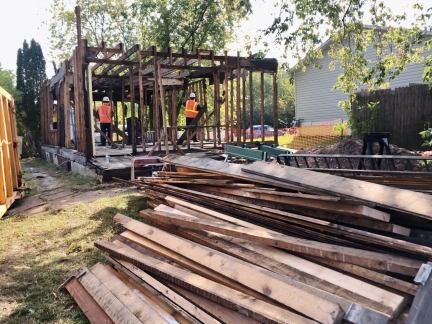Reusing and recycling materials from construction and demolition (C&D) can help address pressing disposal and contamination issues in Minnesota, and have significant economic and environmental benefits.
Deconstruction and salvage

Deconstruction can be as simple as removing rather than demolishing cabinetry or as involved as dismantling a whole building. Non-structural deconstruction, or salvage, is reclaiming high-value materials such as appliances, doors and windows, lighting fixtures, cabinets, and other finishing materials. Structural deconstruction retains structural components, such as framing lumber, sheathing, bricks, and hardwood flooring, for reuse or recycling. Projects that use deconstruction may benefit from tax deductions for donated materials, reduced or avoided landfill tipping fees, and revenue from selling reclaimed materials.
Project managers have to consider:
- appraised value of the materials
- distance to recycling markets or reuse stores
- demand for reclaimed materials
- availability of deconstruction contractors
- hazardous material considerations such as asbestos and lead
- landfill tipping fees
- labor cost and project timeline
- local ordinances
Visit the Reuse Ecosystem Map on the All for Reuse website to find deconstruction and salvage organizations in your area.
Recycling
Turning the 1.6 million tons of Minnesota C&D waste into recycled resources depends on the availability of markets. Some materials such as cardboard, metals, and plastics have established recycling markets. However other materials, such as sheetrock, do not.
Common types of C&D waste:
- Wood is the largest portion of C&D waste at 15.5%. "Clean" wood such as tree waste, non-treated lumber, and and pallets are used for animal bedding, mulch, and biomass fuel. "Mixed" woods, such as plywood, painted wood, particle board, and furniture can be used for biomass fuel in some situations.
- Aggregate is 13.4% of the waste stream and includes concrete, asphalt, and brick materials. After processing, it can be used in roadways, foundations, and parking structures.
- Roofing shingles are 19.3% of the waste stream, and in demand because of the high-cost of virgin asphalt. In Minnesota, up to 5% of the weight of plant-mixed asphalt used on roads may be from recycled shingles.
- Wallboard or drywall is about 8.1% of C&D waste.
- Carpet and padding is 4% of C&D waste and can only be recycled by state residents in a few areas.
- Plastic such as PVC pipe, packaging, film, vinyl siding, and buckets makes up about 0.3% of C&D waste and can be recyclable if it's clean.
- Metals, primarily aluminum, copper, and steel, are 2.5% of the waste stream and readily recyclable.
- Paper, mostly cardboard, is 3% of the waste stream and has well-established recycling markets in Minnesota.
Source: Construction and demolition materials composition study (2020)
On-site separation vs. mixing materials
Separating materials on-site can keep them free of contamination and more desirable as recyclables. If you have a sufficient volume of material, it may be economical to hire a contractor or rent processing equipment (crusher, grinder, shredder). Processing may reduce transportation costs and allow you to deliver the material directly to market.
C&D material recovery facilities can sort and process mixed materials and commonly recover 50 to 75% of materials by weight.
C&D material recovery facilities in Minnesota:
- Atomic Recycling, Minneapolis
- Dem-Con Recovery & Recycling, Shakopee
- SKB Environmental, Rosemount
- Veit Como Recycling & Transfer, Minneapolis
Moving buildings
Relocating a building can eliminate the labor, waste, and hazardous disposal costs associated with traditional demolition, and it preserves the resources used to create the building. It may be a more expensive option, particularly for larger buildings or longer distance moves. Find a list of structural movers in the state:
Hazardous waste considerations
It's important to properly manage hazardous wastes generated at construction and demolition sites.